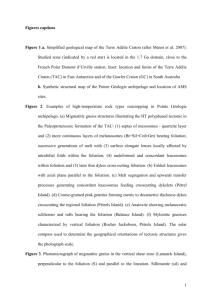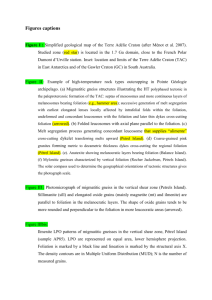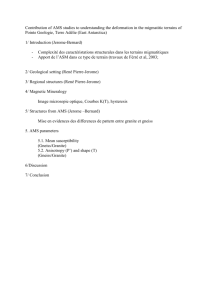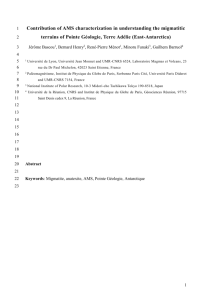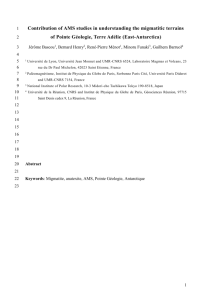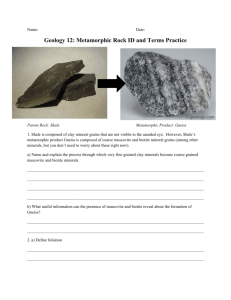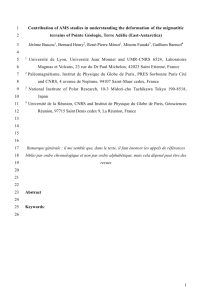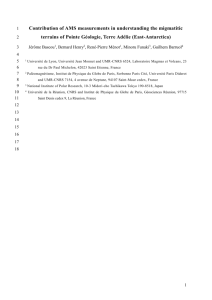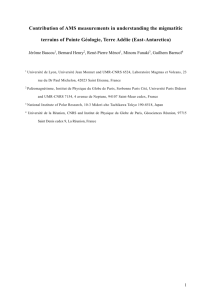Introduction AMS study has been applied to the migmatitic and
advertisement
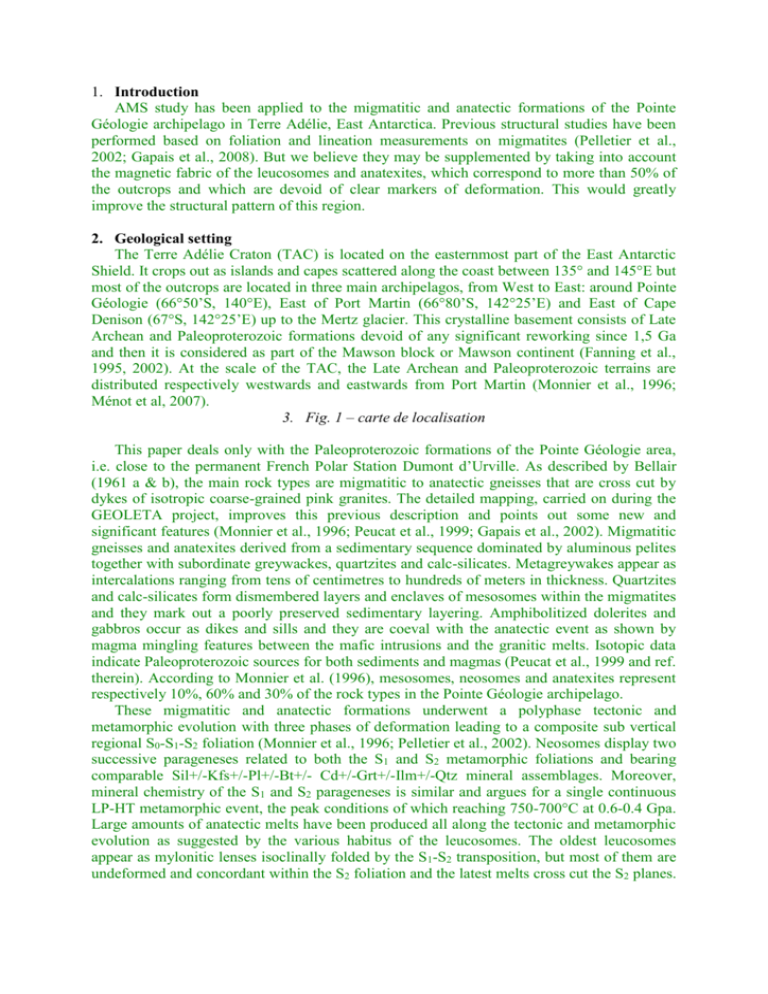
1. Introduction AMS study has been applied to the migmatitic and anatectic formations of the Pointe Géologie archipelago in Terre Adélie, East Antarctica. Previous structural studies have been performed based on foliation and lineation measurements on migmatites (Pelletier et al., 2002; Gapais et al., 2008). But we believe they may be supplemented by taking into account the magnetic fabric of the leucosomes and anatexites, which correspond to more than 50% of the outcrops and which are devoid of clear markers of deformation. This would greatly improve the structural pattern of this region. 2. Geological setting The Terre Adélie Craton (TAC) is located on the easternmost part of the East Antarctic Shield. It crops out as islands and capes scattered along the coast between 135° and 145°E but most of the outcrops are located in three main archipelagos, from West to East: around Pointe Géologie (66°50’S, 140°E), East of Port Martin (66°80’S, 142°25’E) and East of Cape Denison (67°S, 142°25’E) up to the Mertz glacier. This crystalline basement consists of Late Archean and Paleoproterozoic formations devoid of any significant reworking since 1,5 Ga and then it is considered as part of the Mawson block or Mawson continent (Fanning et al., 1995, 2002). At the scale of the TAC, the Late Archean and Paleoproterozoic terrains are distributed respectively westwards and eastwards from Port Martin (Monnier et al., 1996; Ménot et al, 2007). 3. Fig. 1 – carte de localisation This paper deals only with the Paleoproterozoic formations of the Pointe Géologie area, i.e. close to the permanent French Polar Station Dumont d’Urville. As described by Bellair (1961 a & b), the main rock types are migmatitic to anatectic gneisses that are cross cut by dykes of isotropic coarse-grained pink granites. The detailed mapping, carried on during the GEOLETA project, improves this previous description and points out some new and significant features (Monnier et al., 1996; Peucat et al., 1999; Gapais et al., 2002). Migmatitic gneisses and anatexites derived from a sedimentary sequence dominated by aluminous pelites together with subordinate greywackes, quartzites and calc-silicates. Metagreywakes appear as intercalations ranging from tens of centimetres to hundreds of meters in thickness. Quartzites and calc-silicates form dismembered layers and enclaves of mesosomes within the migmatites and they mark out a poorly preserved sedimentary layering. Amphibolitized dolerites and gabbros occur as dikes and sills and they are coeval with the anatectic event as shown by magma mingling features between the mafic intrusions and the granitic melts. Isotopic data indicate Paleoproterozoic sources for both sediments and magmas (Peucat et al., 1999 and ref. therein). According to Monnier et al. (1996), mesosomes, neosomes and anatexites represent respectively 10%, 60% and 30% of the rock types in the Pointe Géologie archipelago. These migmatitic and anatectic formations underwent a polyphase tectonic and metamorphic evolution with three phases of deformation leading to a composite sub vertical regional S0-S1-S2 foliation (Monnier et al., 1996; Pelletier et al., 2002). Neosomes display two successive parageneses related to both the S1 and S2 metamorphic foliations and bearing comparable Sil+/-Kfs+/-Pl+/-Bt+/- Cd+/-Grt+/-Ilm+/-Qtz mineral assemblages. Moreover, mineral chemistry of the S1 and S2 parageneses is similar and argues for a single continuous LP-HT metamorphic event, the peak conditions of which reaching 750-700°C at 0.6-0.4 Gpa. Large amounts of anatectic melts have been produced all along the tectonic and metamorphic evolution as suggested by the various habitus of the leucosomes. The oldest leucosomes appear as mylonitic lenses isoclinally folded by the S1-S2 transposition, but most of them are undeformed and concordant within the S2 foliation and the latest melts cross cut the S2 planes. A retrograde imprint with Bt+/-Ms+/-And assemblages marks the later evolution to about 550-450°C and 0.5-0.4 Gpa (Monnier et al., 1996; Pelletier et al., 2002, 2008). Bellair and Delbos (1962) assumed a 1.5 Ga age (Rb/Sr on micas) for the partial melting event. More recently (Peucat et al., 1999), new radiometric data (U-Pb on zircons and monazites, Sm-Nd and Rb-Sr on whole rocks and minerals) gave precise time constraints on the geological evolution of the meta-volcano sedimentary formations of Pointe Géologie. Time of deposition is bracketed between the inherited zircon ages (1.72 -1.76 Ga) and the peak metamorphism and partial melting age at 1.69 Ga. The later cooling path was constrained by Nd garnet ages (650-600°C at 1.63-1.60 Ga) and Rb-Sr muscovite and biotite ages (450-350°C at 1.5 Ga). 4. Petrography and field relationships As the magnetic characteristics of the rocks are tightly controlled by their mineralogical content, the various assemblages recorded in the different rock types need to be precised. This is particularly important in the case of migmatitic gneisses where partial melting induces a redistribution of refractory minerals from the mesosome to both the melanosomes and leucosomes. This may lead to different magnetic properties for both parties of the neosome. According to Monnier et al. (1996) and Pelletier et al. (2005), K-feldpar gneisses, occurring as stromatitic migmatites, represent the main rock type of the Pointe Géologie archipelago. Syn-S1-2 parageneses consists of Qtz (55%) + Kfs (14%) + Pl (13%) + Crd (14%) +/- MagIlm-Sp (3%) +/- Bt (1%) in the leucosomes and Crd (50%) +Sil (12%) + Bt (8%) + Mag-IlmSp (12%) + Qtz (10%) +/- KFs (5%) +/- Pl (3%) in the melanosomes. Fig. IIa : Lame OM40 ou photo A planche III (in Monnier); lameDDU 49d ou photo C planche III). This thin section clearly points out migration of the relict Fe-Ti oxides from melanosome to leucosome. During that migration, oxides lose their original orientation along the gneissic foliation and are distributed without orientation in leucosomes. (1)1 While the lithology is very homogeneous in the scale of the archipelago, field relationships between different rock types are much more complex for the scale of outcrops. Four main rocks types have been sampled for AMS measurements: migmatites including leucosomes and melanosomes, anatexites, coarse-grained pink granites and strongly mylonitic gneisses. Migmatitic gneisses: They have been described previously as the K feldspar gneisses and they are the dominant facies of the area, especially on the Pétrels Island (Fig. I and VIII). We will discuss more specifically the space, and the time, relationships between leucosomes and melanosomes in the migmatitic gneisses. As partial melting developed all along a polyphase tectonic and metamorphic event, leucosomes display various habitus relative to the composite foliation, which is marked on the field by melanosomes and septas of mesosomes. The melanosomes defined continuous layers in migmatites (Fig IIb and ??? : photos terrain de migmatites rubannées).: (i) The earliest leucosomes occur as mylonitized and elongated lenses, sometimes affected by intrafolial folds within the foliation. They bear evidence of successive segregation and deformation processes. (1) Faut-il faire une description plus détaillée de l’habitus des minéraux ? Si oui on peut partir de la description de Pelletier et al., 2005, p. 157 (ii) (iii) The most common leucosomes are undeformed and concordant within the migmatites foliation and they may be later folded together with the foliation. They represent syn to late foliation melts The latest leucosomes form dykelets cross-cutting, and post-dating, the S1-2 foliation They may be connected to the concordant leucosomes, tapping off and transferring melts upwards. Mylonitic gneisses: they outcrop in a restricted and narrow zone on the western flank of the Pétrels Island (Rocher Jakobsen), i.e. along a major shear zone (Fig. VI and VII). They consist of Bt + Grt gneisses with only tiny Grt-bearing leucosomes and are characterized by a vertical mylonitic foliation. They derive from the K-feldspar migmatitic gneisses and then may be considered as late to post migmatisation tectonites. (Fig. IIe : affleurement Jakobsen avec petits leucosomes à grenat OU lames mince OU aucune photo ???) Anatexites: They outcrop widely on the Gouverneur Island and the NW area of the Pétrels Island (Fig. 1 and VII). They derived from a higher degree of partial melting than migmatitic gneisses and show a mineral assemblage comparable to that of leucosomes but more enriched in Qtz and depleted in Crd. Anatexites display more isotropic textures but a flow fabric or a palimpsest structure of the parent gneisses is often marked by some oriented rafts of migmatitic gneisses or schlierens of biotite and oxides (Fig. IIc : photos terrain des anatexites de Gouverneur) Coarse grained pink granites: they appear as dikes of metric to decametric thickness which cross cut the regional foliation. Their mineralogy is similar to that of anatexites and they are devoid of any markers of orientation. Such dikes, collecting the dikelets, drain the more evolved melts during the late to post tectonic stages of the partial melting and metamorphic event. (Fig. IId : photos terrain filons de granite rose – panorama Pétrels, NW hangar bleu ?) 5. Regional structures As carefully described by Pelletier et al. (2002) and Gapais et al. (2008), the Pointe Géologie archipelago show two types of structural domains: domes and NS to N340° striking vertical shear zones which develop during the metamorphic and anatectic event (see Fig. 1 and 2 in Pelletier et al., 2002). Between the vertical zones, foliation attitudes point out dome-shaped structures marked by flat lying to gently dipping fabrics. Dome display a mineral lineation outlined by a preferred orientation of sillimanite crystals while such a lineation is almost invisible in the vertical zones. The transition from flat lying to vertical foliation zones may be sharp, with development of vertical foliation planes cutting across the horizontal foliation of domes, or gradual when folds, with horizontal axes, induce vertical planes. Such a transition from dome to vertical shear zone never exceeds five hundred meters in thickness. In both cases, vertical structures seem to be later than flat lying ones. According Gapais et al. (2008), the kinematic markers (lineations, boudinage, ...) suggest that shear zones reflect a dextral transpressive movement while flat areas are the result of shortening combined with stretching parallel to the shear zones. Such patterns might be explained in the frame of a regional convergence of a hot and weak juvenile crust leading to horizontal crustal flow and strain partitioning with localized deformation along transpressional shear zones. Interpretation References (RPM) 1- BELLAIR (1961) - Sur les formations anciennes de l'archipel de Pointe Géologie (Terre Adélie). Comptes rendus de l'Académie des Sciences, Paris, 252: 3087-3089. 2- BELLAIR 1961 - Pétrographie du socle cristallin de la Terre Adélie. Comptes rendus de l'Académie des Sciences, ,Paris, 252: 32963298. 3- BELLAIR & DELBOS, 1962 - Age absolu de la dernière granitisation en Terre Adélie. Comptes Rendus de l'Académie des Sciences, Paris, 254: 1465-1466. 4- FANNING C.M., DALY S.J., BENNETT V.C., MÉNOT R.P., PEUCAT J.J., OLIVER R.L. (1995) - The “ Mawson Block ” : once contiguous Archean to Proterozoic crust in the East Antarctic Shield and Gawler Craton, Australia. VII International Symposium on Antartic Earth Sciences, 10-15/09/1995, Sienna, Italy. 5- FANNING C.M., MÉNOT R.P., PEUCAT J.J., PELLETIER A., (2002) – A closer examination of the direct links between Southern Australia and Terre Adélie and George V Land, Antarctica. 16th Australian Geological Congress, AGC, Special session in memory of Robin Oliver “ Geology of East Antarctica and its links with Australia and the other southern, continents”, Adelaïde, 30 June – 5 July 2001, Geoscience 2002: Expanding horizons, Abstracts vol. n°67, p.224. 6- GAPAIS D., PELLETIER A., MÉNOT R.P., PEUCAT J.J., (2008) - Paleoproterozoic tectonics in the Terre Adélie Craton (East Antarctica). Precambrian Research, 162, 3-4, 531-539, doi: 10.1016/j.precamres2007 7- MÉNOT R.P DUCLAUX, G., PEUCAT, J.J., ROLLAND, Y., GUILLOT, S. FANNING, M., BASCOU, J., GAPAIS, D., PECHER, A., (2007) – Geology of the Terre Adélie Craton (135 146°E), in Antarctica: A Keystone in a Changing World—Online Proceedings for the Tenth International Symposium on Antarctic Earth Sciences, edited by Alan Cooper, Carol Raymond et al., USGS Open-file Report 2007-1047, Short Paper 048, 5p.; doi:10.3133/of2007-1047.spr048. 8- MONNIER O., MÉNOT R.-P., PEUCAT J.J., FANNING M., GIRET A. (1996) - Actualisation des données géologiques sur Terre Adélie (Antarctique Est) : mise en évidence d’un socle protérozoïque hétérogène. . Comptes rendus de l'Académie des Sciences, Paris ,322, IIa, 55-62. 9- PELLETIER A., GUIRAUD M., MÉNOT R.P. (2005) – From partial melting to retrogression in the Pointe Géologie migmatitic complex (East Antarctica): a history of heterogeneous distribution of fluids. Lithos, 81, 153-166. 10- PELLETIER A., GAPAIS D., MÉNOT R.P, PEUCAT J.J., (2002) – Tectonique transpressive en Terre Adélie au Paléoprotérozoïque (Est Antarctique). Comptes rendus Geosciences, 334, 505-511. 11- PEUCAT J.J., MÉNOT R.P., MONNIER O., FANNING M., (1999) – The Terre Adélie basement in the East-Antarctica Shield : geological and isotopic evidence for a major 1.7 Ga thermal event ; comparison with the Gawler Craton in South Australia. Precamb. Res. .94, 205-224 Figures captions Figure I : Carte de localisation (carte archipel avec structure GApais + localisation mondiale) Figure II : Planche 4-6 photos (incluant photo lame-mince) Figure III : PKm : ensemble des données Figure IV : Figure KT: AP85 par exemple + … Figure V : Figure loops: AP90 par exemple + … Figure VI :Figure Day: Figure VII : Carte ASM générale Figure VIII : Carte ASM Pétrel Figure IX : Figure P'T: ensemble des données ??? (Possibilité de faire moyennes sur figures précédentes) Figure X/ Synthèse, bloc diagramme ? Synthèse stéréo ? granite versus gneiss ? Figure stereos: ensemble des données Figure Petrels: diagrammes par site Figure DDU: diagrammes par site Figure P'T: ensemble des données
